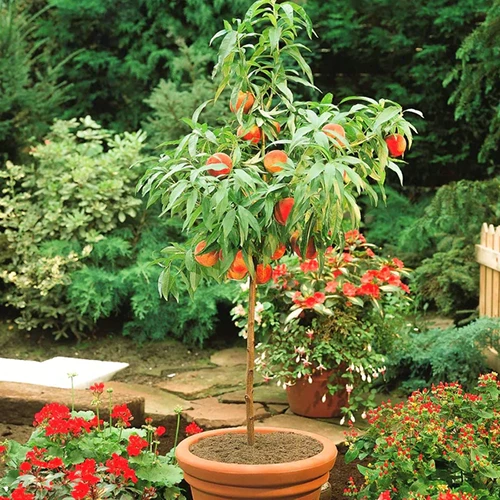All About Dwarf Patio Peach
The Rich History of Dwarf Patio Peach
Historical records show that Dwarf Patio Peach trees were present in ancient Chinese and Persian gardens centuries ago. Throughout history, people have grown small trees that bear fruit because they offer both decorative appeal and fruit yield. During the Renaissance period, European botanists and horticulturists began experimenting with grafting methods to produce miniature fruit trees that retained productivity while becoming easier to manage. Scientific progress in horticulture enabled the development of fruit-bearing varieties that could flourish in small spaces. In the 20th century, breeders developed this tree's modern version by enhancing its disease resistance and adaptability while improving its visual appeal.
Medical Uses Through the Ages
Historically, people have appreciated this tree for its medicinal qualities, which come from different parts of the tree. Traditional medicine utilizes the leaves, bark, and fruit from this tree. Ancient Chinese practices involved brewing teas from leaf and bark extracts, which helped improve digestion and reduce inflammation. As a traditional digestive aid, the fruit contains natural fibers and compounds that help relieve constipation and improve gut health.
The blossoms have been traditionally utilized by herbalists in tinctures and decoctions to promote respiratory well-being. These fragile flowers hold flavonoids and antioxidants that traditional medicine uses to treat bronchial problems. Amygdalin within the fruit's pit was previously thought to have anticancer properties, but modern medical research rejects this idea because it becomes toxic when consumed in large amounts.
The First Discovery of This Tree
The natural habitat of the Dwarf Patio Peach traces back to Asia, where its wild relatives thrived in mountainous areas with moderate weather conditions. Ancient Persian documents show that traders and gardeners developed small fruit tree varieties centuries ago because they could adapt to many different environments. The expansion of trade routes enabled these trees to gain popularity throughout the Mediterranean until they appeared in European gardens during the Middle Ages. Dedicated growers in the United States successfully developed these trees to flourish in limited spaces while delivering plentiful blossoms and fruit by the 1800s.
Dwarf Patio Peach: A Stunning Addition to Landscapes
Gardeners and landscape designers appreciate this tree because of its exceptional adaptability. This plant outperforms full-sized fruit-bearing varieties for container gardening as well as courtyard and urban landscape applications. Its small size enables the tree to blend well into limited spaces without dominating nearby plants. The tree's springtime blossoms generate an eye-catching display through soft pink flowers, which add energy to patios, balconies, and garden beds.

This tree serves as a central feature in mixed plantings when paired with ornamental grasses, low-growing perennials, and evergreen shrubs, according to many gardeners. This plant serves as an attractive feature in rock gardens while enhancing walkways and entryways through its decorative presence. This plant thrives in container gardening conditions, which makes it ideal for rooftop gardens where limited space requires a specific selection of plants. Pruning this tree allows gardeners to form either a formal or informal structure based on their aesthetic preferences.
The Visual Appeal of Dwarf Patio Peach
The overall appearance of Dwarf Patio Peach stands out as one of its most remarkable features. The plant reaches a practical height and maintains rich green leaves throughout the entire growing period. At the start of spring, delicate pink blossoms appear in abundance on the branches, while pollinators are drawn and give the landscape an early splash of color. After the blossoms fade, small fruit starts to develop, showing color changes from green to bright orange and red shades. Its velvety skin texture contributes to the fruit's distinct visual appeal.
During autumn months, the foliage transforms into a rich golden color, which enhances the tree’s beauty when seasonal changes occur. The tree maintains its aesthetic appeal during winter months when its leaves drop as garden lights highlight its shape or evergreens create a contrasting background. The tree’s continuous aesthetic appeal throughout all seasons makes it perfect for anyone who wants a visually stunning tree at any time of the year.
Rare Wildlife That Finds Refuge Here
This tree may be small, but it provides essential support for wildlife in the area. The tree's delicate flowers draw in numerous pollinators, such as bees, along with butterflies and hummingbirds during its flowering phase. These species find a critical food source in the nectar-rich blooms during early spring because few other flowers bloom at this time.
The tree produces fruit, which serves as food for multiple bird species and small mammals. Various songbirds, such as finches and thrushes, frequent these trees to obtain ripe fruit. The tree's foliage and branches offer a protective habitat for beneficial insects that support ecosystem health. This tree becomes an ideal refuge for caterpillars and larvae in areas where butterfly species depend on particular host plants. The tree's fruit, combined with flowers and foliage, makes it essential to a biodiverse garden.
The Benefits of This Tree in Landscapes
The Dwarf Patio Peach tree provides multiple benefits to both professional landscapers and residential gardeners. This tree stands out for its exceptional ability to grow well in limited spaces. This tree species stands out from traditional orchard trees because it flourishes within limited space and serves well for plantings in urban gardens as well as patio and balcony areas.
Another advantage is its aesthetic versatility. The plant adds year-round visual appeal through its stunning blooms and foliage when used as a focal point or integrated into formal gardens. The ability to grow it in containers raises its utility because gardeners can move it according to seasonal demands or design choices.
The species attracts pollinators, which helps maintain local biodiversity. When gardeners plant this tree, they help maintain healthy bee and butterfly populations, which supports plant growth in their vicinity. Eco-conscious gardeners benefit from its low demands for water and fertilizer, which makes this plant a sustainable option. A low-maintenance tree provides attractive aesthetics, consumable fruit, and essential ecological services to its caretaker.